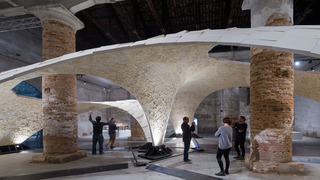Computational Structural Design II
This course teaches structurally-informed computational design and digital fabrication methods for compression-only shell structures.
Disclaimer
The teaching materials shown in this platform are the result of a collaboration between the Chair of Architecture and Structure (Prof. Dr. Philippe Block) and the Chair of Structural Design (Prof. Dr. Joseph Schwartz) during the years 2015-2022. This platform is not updated since June 2023. If you are a bachelor or master student in Architecture at ETH Zürich, please follow the courses’ content in ETH’s Moodle learning platform in order to get the actualised course material.
Abstract
This course teaches structurally-informed computational design, materialisation, and subtractive fabrication methods for compression-only shell structures. The course is an introduction to coding using the Python programming language within the context of computational structural design.
The students will first learn about Thrust Network Analysis (TNA), a form-finding method for compression-only shell structures. Using compas-RV2 (RhinoVAULT 2), an interactive implementation of TNA for Rhinoceros software, the students will learn how to design and analyse their own funicular shell structures.
After being introduced to the basics of Python programming using Jupyter Notebook, the students will learn how to use the COMPAS framework for processing computational geometry to develop various materialisation strategies. Students will also learn about the mesh datastructure, and how to use various features of COMPAS to understand, extract and process topological information stored in the datastructure.
Finally, using the form-found geometry using compas-RV2 and the computational skills learned in class, the students will learn the basic principles of digital-design-to fabrication setup and workflow, and develop a subtractive fabrication pipeline for wirecutting and CNC milling of discretised block geometries of the compression-only structure.
Learning goals
After successfully completing the course, the students will be able to:
1. design, form find and analyse compression-only shell structures using Thrust Network Analysis and RhinoVAULT 2 (RV2).
2. develop their computational design and algorithmic thinking.
3. code basic Python scripts using Jupyter Notebook.
4. use the COMPAS framework for processing computational geometry and materializing mesh data structures.
5. understand the basic principles of digital-design-to-fabrication pipeline and setup.
6. understand and develop skills in subtractive fabrication methods (CNC milling).
7. conceptualize and design efficient structural forms informed by fabrication constraints.
Evaluation
Graded semester performance
Registration
Registration at http://www.mystudies.ethz.ch/ is required.
Coordination
Dr. June Lee
MSc Arch Serban Bodea
